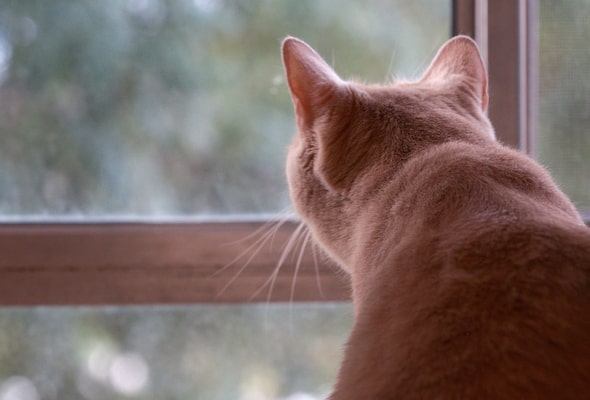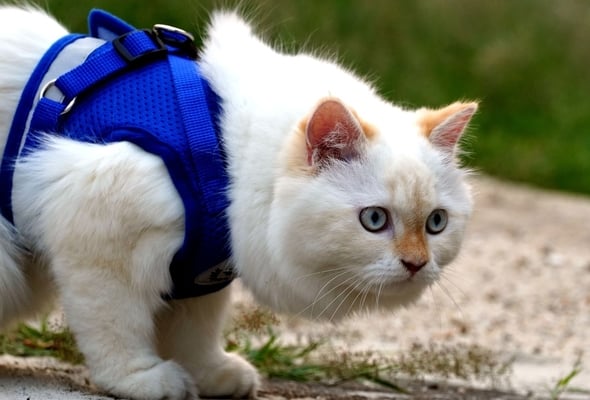One of the joys of owning a dog is being able to take it on walks. While a pleasure for some, this twice to three times daily responsibility can be a burden. On the other hand, cats are known for being indoor creatures, content and happy to spend their lives within your home.
This makes cats an attractive option for homebodies or those with busy schedules. However, while content indoors, cats can and do also enjoy spending time outside. Because of this, some owners may feel compelled to give their cats a taste of outdoor freedom. So, can I take my cat for a walk?
Can I Take My Cat for a Walk?
Yes, you may be able to take your cat for a walk. Although it is less common for people to take cats on walks, it is possible, and your cat may enjoy the exercise and fresh air. That said, not all cats enjoy being taken on walks, and an interest in the outdoors can vary greatly between individuals.
While we often consider cats and dogs as opposite sides of the same coin, the truth is that these two species differ greatly in their interests, proclivities, and overall behavior. Albeit possible, walking a cat is not like walking a dog, and it may require effort and training on your part to accustom your cat to walking on a leash.
It should also be noted that most cats do not enjoy being taken on walks. An interest in walks will also depend on the breed of cat, as different breeds are prone to different behaviors and interests in certain activities. If you see someone else taking their cat on a walk, they have likely undergone rigorous training and been acclimated to life outdoors.
Because we know that feral cats enjoy living and spending time outside, it may seem intuitive to believe that this should translate into a willingness to be walked. However, this is not the case, and a feral cat enjoying the freedom of the outdoors is quite different from a cat being taken for a walk on a leash.
In this article we’ll go over why most people do not take their cats on walks, why many cats do not enjoy it, and how and when to know if your cat will enjoy a stroll. We also delve into the differences between walking a cat vs. walking a dog.
Why Do People Not Walk Cats?
Firstly, many people do not walk their cats because they often don’t feel the need to do so. Cats can exist happily indoors, so long as their needs are met and they have exposure to sunshine and fresh air. An unobstructed and open window can suffice to meet this need.

Cats are furtive and private creatures that are incredibly discrete. They take advantage of the nooks and crannies in your home, navigating your indoor environment as a self-contained world. Having shelter and a place to hide is essential to your cat’s happiness, and both of these can be met indoors.
Many people also acquire cats in part because they do not need to be walked. Part of their appeal is their self-sufficiency, and many prospective pet owners look for an affectionate companion that does not demand much of their time. As cats do not require being walked, many owners forgo the responsibility of taking them outdoors.
Moreover, at least compared with dogs, indoor cats are fairly easy to clean up after. All you have to do is provide a litter box and your cat will take care of the rest. Because of this, and due to their smaller size and tidier habits, it is not necessary to take their cat outside for it to use the bathroom.
Lastly, many cats do not enjoy being walked, and owners shy away from activities that could stress out their pet. By the same token, and due to its independent nature, a cat is more likely to run away than a dog, which is a risk that may not be worth taking.
Why Do Some Cats Not Enjoy Walks?
To begin with, many people do not consider cats to be fully domesticated. Unlike dogs, cats have retained their independence, and are still fully equipped to live and thrive on their own. Cats also tend to live alone in the wild, only meeting with other cats to mate and rear their young

However, walking with your pet is a social activity. This clashes with the asocial nature of cats, and they may not have an interest in being attached to you by a leash. To this end, they enjoy the freedom to come and go as they please, spending time with you at their own leisure. The sudden introduction of a harness and leash curbs this freedom and may be frightening for many cats.
Along with retaining their freedom, the secretive nature of cats makes them less than enthusiastic about being exposed and in the open. Unless you’re planning on crawling through the bushes with your pet, walks will necessarily entail your cat’s exposure to things it may normally hide from.
This furtive instinct is natural. Although predators, cats are small mammals that are themselves afraid of being attacked and killed. Loud noises and bright lights can trigger many cats and make them fearful, driving them to hide and seek shelter. Being unable to do so can cause stress, and may ultimately lead to your cat distrusting you.
How Come I Can’t Walk My Cat Like A Dog?
In addition to what we’ve described above, it’s important to note the significant differences between cats and dogs that make dogs better suited for going on walks.
Notably, while cats are largely asocial, dogs are themselves incredibly social creatures. Descended from wolves, dogs naturally spend their lives hunting and living with their extended families. Dog owners are an extension of their pet’s family and pack, and so an owner’s presence provides dogs with the protection and confidence to go outdoors.
As for hunting habits, cats typically hunt by sneaking up on their prey and exploiting the element of surprise. By contrast, dogs are more physically capable and are the top of the food chain, having the courage and physical prowess to hunt in the open, engaging with their prey directly.
This openness to being exposed means dogs are less likely to be afraid of the sights and sounds of the street.
Finally, going back to the issue of domestication, dogs are considered to be fully domesticated and adapted to life with humans. They are wholly dependent on people, making them more trusting of their owners. While often loving towards their owners, cats are often not willing to put their life in their owners’ hands.
How Do I Take My Cat On a Walk?
First and foremost, new owners of cats should not attempt to take their cats on walks. As we’ve already stated, cats can be fearful, and will be displeased if forced outside by someone they barely know. This can take time and effort, and you should learn about your cat’s individual personality before considering taking them on a walk.
A good sign is if your cat readily enjoys being picked up and handled. Cats who trust their owners in this way are typically more comfortable with being leashed. It is also important to recognize if your cat is frightened of loud noises or sudden movements. If your cat is easily triggered, it is probably not a good idea to take them on a walk.
If you think your cat is ready, you may want to start off easy by trying to put a harness on them and seeing if they feel comfortable wearing it. Let them roam around your house in a harness, doing everything they normally would, and see if they try to remove it.
Once your cat is accustomed to its harness, you can then try a leash and practice walking around your home without going outdoors. It may take them a while to get used to the leash, so be patient.
Ultimately, before taking your cat outdoors, you should always defer to a trainer’s insight and instruction to find out the best way to take the next step. Always make sure your leash and harness are secure to prevent your cat from injuring itself or escaping.
Conclusion
While it is certainly possible to take your cat on walks, many cats do not enjoy the activity. It is in their nature to be independent, and being constrained by a leash can frighten many cats. Likewise, cats that are afraid of loud noises or sudden movements should not be walked, as this can cause them unnecessary stress.
If you’re thinking about picking up a cat and training it to go on walks, you should consider researching breeds that are known to be more comfortable with physical intimacy and being put on leashes. Although some breeds may be better suited for going on walks, their desire to do so will also vary from individual to individual.

